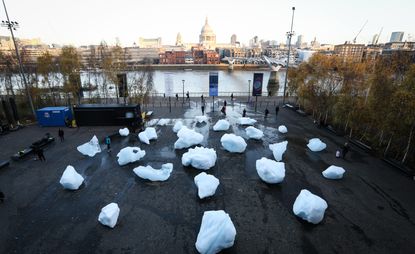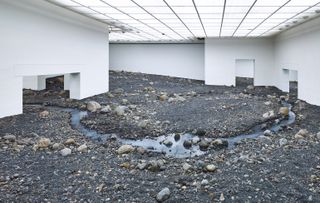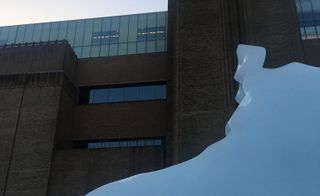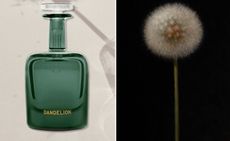Olafur Eliasson’s ‘Ice Watch’ confronts Londoners with the realities of climate change

It's a brisk 1°C on London's Southbank. The sun has just touched the Switch House, and is hastily creeping towards 24 ice boulders arranged at the front of Tate Modern. They're already melting. Great blue-white tears collect in sad puddles, that will eventually glissade into the Thames and vanish.
This is no festive cocktail-inspired installation, and these are no ordinary ice-cubes. This is the third iteration of Icelandic-Danish artist Olafur Eliasson's Ice Watch, an artistic endeavour that aims to draw attention to Greenland's melting ice caps. It debuted in Copenhagen in 2014, and was exhibited in Paris the following year. It's arrival in London marks Eliasson's first outdoor installation in the city, and precedes a major retrospective of his work, expected to be a highlight of Tate Modern's 2019 calendar.

Detail view of Ice Watch, Tate Modern, London.
The morning chill of 1°C snaps at the extremities, as if nature is trying to remind us that the earth's temperature has risen by approximately this much since the turn of the 20th century – and it's ever increasing. Created in collaboration with Minik Rosing, professor of geology at the Natural History Museum of Copenhagen and Denmark, Ice Watch aims to make the impact of climate change a more immediate, physical experience. ‘Since 2015, the melting of ice in Greenland has raised global sea level by 2.5mm,' he explains. ‘Eventually, Greenland's ice waters will flow through the Thames.' This violent destruction of nature is happening silently, almost imperceptively around us. Ice Watch forces us to look.
These particular shards of ice were taken from the waters of the Nuup Kangerlua fjord in Greenland, where they were melting into the ocean after having been lost from the ice sheet. As well as being messengers with political motive, and objects of protest, they are things of striking beauty. Like slabs of marble, each has its own personality: some are near transcluscent, others densely opaque; some have lightly cratered surfaces, others are ice-rink slick. One has a near-neon lightning strike running through its centre. Eliasson predicts it will take around four days for these glacial chunks – some of them truck-sized – to all but disappear. ‘Gather your family, your children, and bring them quickly if they want to see it,’ he advises, poignantly, unintentionally, drawing attention to the speed in which Greenland's ices will slip away from us.
RELATED STORY

To see these things of ethereal natural beauty drip into nothing is what Justine Simons, London's deputy mayor for culture and the creative industries, calls a ‘visceral experience'. It's also jarringly sad, evoking a very real sense of loss. By positioning icebergs as art objects we can touch and connect with, we imbue them with the kind of emotion difficult to apply to scientific abstractions, statistics, or political rhetoric. As the COP24 climate change conference in Katowice, Poland gets under way, having a physical embodiment of environmental disaster thrust in front of us is more important than ever.
A dog splashes a ball through the rapidly forming puddle waterway, a young couple take a wintry selfie, a coterie of school children scratch at the icey edges in gloved hands, cawing ‘Is it real?'. I wonder if the message is sinking in. Yes, it's real. ‘Ten thousand chunks of ice this size disappear every second,' Eliasson reminds us. ‘We must recognise that together we have the power to take individual actions and to push for systemic change. Let's transform climate knowledge into climate action.'

Olafur Eliasson with Ice Watch, 2018

Detail view of Ice Watch, outside Tate Modern.
INFORMATION
Ice Watch can be found outside Tate Modern, and outside the Bloomberg HQ in the City of London.
Until 21 December, weather conditions depending. For more information, visit the Studio Olafur Eliasson website
Wallpaper* Newsletter
Receive our daily digest of inspiration, escapism and design stories from around the world direct to your inbox
Elly Parsons is the Digital Editor of Wallpaper*, where she oversees Wallpaper.com and its social platforms. She has been with the brand since 2015 in various roles, spending time as digital writer – specialising in art, technology and contemporary culture – and as deputy digital editor. She was shortlisted for a PPA Award in 2017, has written extensively for many publications, and has contributed to three books. She is a guest lecturer in digital journalism at Goldsmiths University, London, where she also holds a masters degree in creative writing. Now, her main areas of expertise include content strategy, audience engagement, and social media.
-
 The visual feast of the Sony World Photography Awards 2024 is revealed
The visual feast of the Sony World Photography Awards 2024 is revealedThe Sony World Photography Awards 2024 winners have been revealed – we celebrate the Architecture & Design category’s visual artists
By Ellie Stathaki Published
-
 Don’t Move, Improve 2024: London’s bold, bright and boutique home renovations
Don’t Move, Improve 2024: London’s bold, bright and boutique home renovationsDon’t Move, Improve 2024 reveals its shortlist, with 16 home designs competing for the top spot, to be announced in May
By Ellie Stathaki Published
-
 Perfumer H has bottled the scent of dandelions blowing in the wind
Perfumer H has bottled the scent of dandelions blowing in the windPerfumer H has debuted a new fragrance for spring, called Dandelion. Lyn Harris tells Wallpaper* about the process of its creation
By Hannah Tindle Published
-
 Yinka Shonibare considers the tangled relationship between Africa and Europe at Serpentine South
Yinka Shonibare considers the tangled relationship between Africa and Europe at Serpentine SouthYinka Shonibare‘s ‘Suspended States’ at Serpentine South, London, considers history, refuge and humanitarian support (until 1 September 2024)
By Tianna Williams Published
-
 Gavin Turk subverts still-life painting and says: ‘We are what we throw away’
Gavin Turk subverts still-life painting and says: ‘We are what we throw away’Gavin Turk considers wasteful consumer culture in ‘The Conspiracy of Blindness’ at Ben Brown Fine Arts, London
By Rowland Bagnall Published
-
 Dorothy Hepworth and Patricia Preece: Bloomsbury’s untold story
Dorothy Hepworth and Patricia Preece: Bloomsbury’s untold story‘Dorothy Hepworth and Patricia Preece: An Untold Story’ is a new exhibition at Charleston in Lewes, UK, that charts the duo's creative legacy
By Katie Tobin Published
-
 Don’t miss: Thea Djordjadze’s site-specific sculptures in London
Don’t miss: Thea Djordjadze’s site-specific sculptures in LondonThea Djordjadze’s ‘framing yours making mine’ at Sprüth Magers, London, is an exercise in restraint
By Hannah Silver Published
-
 ‘Accordion Fields’ at Lisson Gallery unites painters inspired by London
‘Accordion Fields’ at Lisson Gallery unites painters inspired by London‘Accordian Fields’ at Lisson Gallery is a group show looking at painting linked to London
By Amah-Rose Abrams Published
-
 Fetishism, violence and desire: Alexis Hunter in London
Fetishism, violence and desire: Alexis Hunter in London‘Alexis Hunter: 10 Seconds’ at London's Richard Saltoun Gallery focuses on the artist’s work from the 1970s, disrupting sexual stereotypes
By Hannah Silver Published
-
 Wayne McGregor’s new work merges genetic code, AI and choreography
Wayne McGregor’s new work merges genetic code, AI and choreographyCompany Wayne McGregor has collaborated with Google Arts & Culture Lab on a series of works, ‘Autobiography (v95 and v96)’, at Sadler’s Wells (12 – 13 March 2024)
By Rachael Moloney Published
-
 Danielle Brathwaite-Shirley confronts gaming, VR and rebirth at Studio Voltaire
Danielle Brathwaite-Shirley confronts gaming, VR and rebirth at Studio VoltaireDanielle Brathwaite-Shirley has opened her first institutional solo exhibition, ‘THE REBIRTHING ROOM’, at Studio Voltaire, London
By Hannah Silver Published